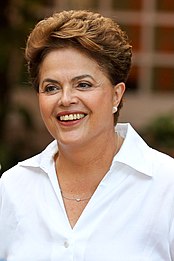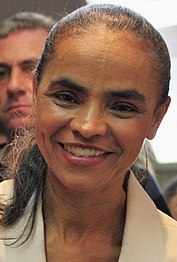2010 Brazilian general election

General elections were held in Brazil on 3 October 2010 to elect the president, National Congress and state governors. As no presidential candidate received more than 50% in the first round of voting, a second round was held on 31 October to choose Luiz Inácio Lula da Silva's replacement as President of Brazil.[1] Lula da Silva had already served two terms after winning the elections in 2002 and being re-elected in 2006.[2]
Candidates
[change | change source]With the support of Lula, the Workers' Party (PT) nominated Dilma Rousseff, a former member and co-founder of the Democratic Labour Party.[3][4] For her vice presidential running mate, Dilma chose Michel Temer, a member of the centre-right Brazilian Democratic Movement, who was President of the Chamber of Deputies.[5]
The centre-right Brazilian Social Democracy Party (PSDB) nominated José Serra, who resigned as Governor of São Paulo to run for president. He had been the presidential nominee of his party in 2002.[6] For his vice presidential running mate, Serra chose Indio da Costa, a conservative Federal Deputy.[7][8]
Marina Silva, a Senator from the northwestern state of Acre and former Minister of the Environment under Lula, left the PT to run for president as a member of the Green Party.[9] Silva, became popular with younger voters and won almost 20% of the vote in the first round.[10]
Results
[change | change source]In the first round, Dilma won 47% of the vote, Serra 33% and Silva 19%. Dilma went on to beat Serra in the second round, becoming the first female President of Brazil.[11] Dilma won 56.05% of the vote against Serra's 43.95% of the vote.
References
[change | change source]- ↑ Colitt, Raymond. "Key dates in Brazil's 2010 presidential race". Reuters. January 11, 2010.
- ↑ Barrionuevo, Alexei. "The Health of a Likely Presidential Candidate Comes Under Brazil's Microscope". The New York Times, May 23, 2009. Retrieved June 14, 2009.
- ↑ "Mares nunca dantes navegados". revista piauí (in Brazilian Portuguese). Retrieved 2020-11-13.
- ↑ "NEWS IN ENGLISH – Dilma Rousseff biography". Jusbrasil (in Brazilian Portuguese). Retrieved 2020-11-13.
- ↑ "Temer é aprovado vice na chapa de Dilma à Presidência – Política". Estadão (in Brazilian Portuguese). Retrieved 2020-11-13.
- ↑ "Editorial: O mal a evitar". O Estado de S. Paulo (in Portuguese). 25 September 2010. Retrieved 27 October 2010.
- ↑ "No Twitter, vice de Serra é comparado a Sarah Palin – 19/07/2010 – Poder – Folha de S.Paulo". m.folha.uol.com.br. Retrieved 2020-11-14.
- ↑ Barrionuevo, Alexei (2010-07-26). "Brazil's President Works to Lend Popularity to a Protégée (Published 2010)". The New York Times. ISSN 0362-4331. Retrieved 2020-11-14.
- ↑ David Maciel. "De Lula à Dilma Roussef: crise econômica, hegemonia neoliberal e regressão política" (PDF) (in Portuguese). Archived (PDF) from the original on 11 November 2013. Retrieved 1 August 2012.
- ↑ "Marina Silva surpreende na reta final e pode gerar segundo turno, diz Instituto Análise | Guilherme Barros". 2010-10-03. Archived from the original on 2010-10-03. Retrieved 2020-11-14.
- ↑ Colitt, Raymond. "Positions of Brazil's leading candidates". Reuters. January 11, 2010.


